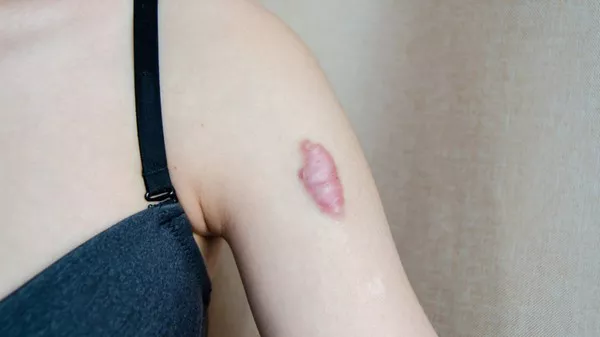Scars are lasting reminders of the body’s remarkable ability to heal itself after injury or surgery. While the initial focus is often on the appearance of a scar, an intriguing question arises with the passage of time: Do scars move with age? Understanding the dynamics of how scars evolve over the years is essential for both medical professionals and individuals seeking insights into the long-term effects of scarring. This article delves into the factors influencing scar movement and explores the scientific and anecdotal evidence surrounding this intriguing phenomenon.
The Anatomy of Scars
Before delving into the intricacies of scar movement, it is essential to grasp the basics of how scars form. When the skin is injured, the body initiates a complex process of tissue repair. Initially, blood clotting occurs to stop bleeding, followed by inflammation to clean the wound of debris and bacteria. Fibroblasts, specialized cells in connective tissue, then produce collagen to replace the damaged skin. The resulting scar tissue often looks different from the surrounding skin due to variations in color, texture, and thickness.
Do Scars Move with Age?
The idea that scars move with age might sound like a peculiar notion, but it has been a topic of discussion in both medical and layman circles. Some individuals claim that scars appear to shift or change position over time. Scientifically, the consensus is that scars do not physically move on the skin. However, the perception of scar movement can be influenced by various factors, including changes in skin elasticity, weight fluctuations, and the natural aging process.
Skin Elasticity and the Illusion of Scar Movement
One of the primary factors contributing to the illusion of scars moving with age is changes in skin elasticity. Skin elasticity refers to the skin’s ability to stretch and return to its original state. Over time, factors such as collagen loss, reduced production of elastin fibers, and the effects of sun exposure can impact skin elasticity. As skin loses its firmness and resilience, scars may appear to change position, when in reality, the surrounding skin is undergoing transformations that affect the scar’s relative appearance.
The Role of Weight Fluctuations in Scar Perception
Weight fluctuations throughout life can also influence the way scars are perceived. Significant weight gain or loss can alter the tension on the skin, causing it to stretch or contract. Scars located in areas prone to such changes may seem to shift in position as the skin undergoes these alterations. For example, abdominal scars from surgeries or injuries may be affected by changes in body weight, leading to the impression that the scar has moved.
Understanding the Natural Aging Process and Scarring
As the body ages, the skin undergoes various changes that can impact the appearance of scars. Collagen production decreases, leading to thinner and more fragile skin. Additionally, the skin’s ability to retain moisture diminishes, contributing to dryness and potential changes in texture. While scars themselves do not physically move, the alterations in the surrounding skin can create the illusion of movement, especially when observed over an extended period.
Factors Influencing Perceived Scar Movement
Location of the Scar: The location of a scar on the body can significantly influence how it appears to change over time. Areas prone to movement and stretching, such as joints, may give the impression of scar movement due to the dynamic nature of the skin in these regions.
Type of Scar: Different types of scars, such as hypertrophic scars, keloids, or atrophic scars, may respond differently to the aging process. For instance, hypertrophic scars and keloids, characterized by excessive collagen production, may be more noticeable as skin elasticity diminishes with age.
Individual Healing Response: Variations in individual healing responses can contribute to differences in scar perception. Some individuals may experience more significant changes in skin texture and elasticity than others, influencing the apparent movement of scars.
Sun Exposure: Prolonged sun exposure can accelerate the aging of the skin and impact the appearance of scars. UV radiation can break down collagen fibers, leading to increased wrinkling and changes in skin texture, which may contribute to the perceived movement of scars.
Scientific Perspectives on Scar Movement
From a scientific standpoint, scars themselves do not move on the skin. Once the wound has healed, the collagen fibers that make up the scar tissue remain in place. However, the surrounding skin undergoes a continuous process of renewal and aging. As this happens, changes in skin texture, thickness, and elasticity can influence the way scars are perceived.
Research suggests that scar tissue does not have the same dynamic properties as normal skin. Unlike the surrounding skin, scars lack hair follicles, sweat glands, and other structures that contribute to the natural movement and elasticity of the skin. Therefore, any observed changes in the appearance of scars are more likely associated with alterations in the adjacent skin rather than the scars themselves physically moving.
Coping with the Perception of Scar Movement
For individuals grappling with the perception that their scars are moving with age, it’s essential to approach the issue with a combination of understanding and proactive care. While scars may not relocate on the skin, addressing the factors contributing to changes in skin texture and elasticity can help improve the overall appearance of scars.
Skin Care and Moisturization: Regular moisturization can contribute to skin health and reduce the dryness that may accompany aging. Applying moisturizers containing ingredients like hyaluronic acid and ceramides can help maintain skin hydration and improve its texture.
Sun Protection: Protecting the skin from harmful UV rays is crucial in minimizing the impact of sun-induced aging. Using sunscreen with a high SPF, wearing protective clothing, and seeking shade can prevent accelerated skin aging and preserve the appearance of scars.
Healthy Lifestyle Choices: Adopting a healthy lifestyle can positively influence overall skin health. This includes staying hydrated, maintaining a balanced diet rich in vitamins and antioxidants, and avoiding harmful habits such as smoking, which can contribute to premature aging.
Consultation with Healthcare Professionals: If individuals remain concerned about the appearance of scars or perceive changes that cause distress, consulting with healthcare professionals, such as dermatologists or plastic surgeons, can provide valuable insights. These professionals can offer tailored advice and, if necessary, recommend appropriate interventions.
Conclusion
In the intricate tapestry of the human body, scars stand as testaments to resilience and healing. While the idea of scars physically moving with age may be a misconception, the perception of scar movement is a complex interplay of various factors, including changes in skin elasticity, weight fluctuations, and the natural aging process. Understanding the dynamics of scar perception empowers individuals to take proactive steps in caring for their skin and addressing concerns related to the appearance of scars. With a combination of proper skincare, lifestyle choices, and, when needed, professional guidance, individuals can navigate the journey of aging with grace and confidence, embracing the stories that their scars tell.
[inline_related_posts title=”You Might Be Interested In” title_align=”left” style=”list” number=”6″ align=”none” ids=”3576,3574,3572″ by=”categories” orderby=”rand” order=”DESC” hide_thumb=”no” thumb_right=”no” views=”no” date=”yes” grid_columns=”2″ post_type=”” tax=””]
































